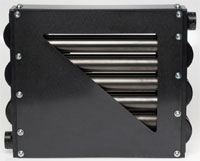| MAIN |
Celanese: Ingenious Polymer and Ceramic Combination Replaces Metal Components| Subj: Press-releses  Celanese Corporation, the global technology and specialty materials company, showcased an innovative Bomat Profitherm heat exchanger with Fortron® polyphenylene sulfide (PPS) components at K 2013 in Düsseldorf, Germany. Celanese Corporation, the global technology and specialty materials company, showcased an innovative Bomat Profitherm heat exchanger with Fortron® polyphenylene sulfide (PPS) components at K 2013 in Düsseldorf, Germany.High-temperature resistant Fortron PPS is used in both the complex water-carrying housing components (water distributor) and the side panels, while the heat exchange tubes are ceramic. This ingenious material combination enabled Bomat to produce a first-of-kind heat exchanger without any metal in the exhaust gas section. Eliminating the high-alloy steels and aluminum from the exhaust gas section prevents the acidic flue gas condensate from dissolving any metal ions, especially heavy metal ions such as nickel and chromium. In every heating system, the flue gas condensate is discharged via the conventional waste water system, but this new technology prevents aluminum or heavy metal ions from entering the water cycle and damaging the environment. This means operators of heating systems and cogeneration heat and power plants (CHP) can obtain significantly more energy from their fuel and save natural resources, as well as reduce the environmental impact by decreasing the release of heavy metals. Celanese was involved in the development of the new Bomat Profitherm heat exchanger from the beginning. Early involvement, which helped Bomat avoid unnecessary development loops and meet its ambitious timeline, focused on component design, supplemented by structure simulation and extensive calculation of mold filling, fiber alignment and weldline positions. In addition, extensive material and application knowledge, and technical support were an absolute pre-requisite. As the material of choice for the innovative Bomat Profitherm heat exchanger, Fortron PPS provides: · Excellent resistance to the acidic flue gas condensates that arise in oil and gas burners and CHP · Very good resistance to heating oil and fuel gases · Outstanding heat distortion temperature · High strength and stiffness · Improves production of parts to the precision specified · Coefficient of linear thermal expansion similar to that of steel that, in combination with metal add-on pieces, results in lower thermal stress and forces acting on the components · Enables ready-to-use parts: Die-cut without any further reworking · More favorable overall energy balance than with customary metal cast parts; no mechanical reworking or corrosion protection required · Considerably lower component weights that simplify storage, transport and assembly · Possibility to use less expensive plastic direct screw fittings without the need for inserts Eric Folz, Celanese design engineer, explains: “Increasing energy efficiency and saving resources — these are substantial contributions to a livable future. We are pleased we were able to help BOMAT in this new application. Bomat has been committed to these goals for more than 20 years and trusts in the efficiency of our polymers.” Celanese Corporation is a global technology leader in the production of differentiated chemistry solutions and specialty materials used in most major industries and consumer applications. With sales almost equally divided between North America, Europe and Asia, the company uses the full breadth of its global chemistry, technology and business expertise to create value for customers and the corporation. Celanese partners with customers to solve their most critical needs while making a positive impact on its communities and the world. Based in Dallas, Texas, Celanese employs approximately 7,400 employees worldwide and had 2013 net sales of $6.5 billion. Source: Celanese Previous news |
© 2002—2025 PLASTINFO